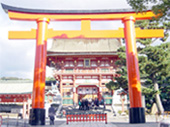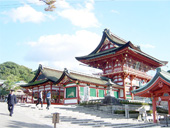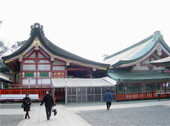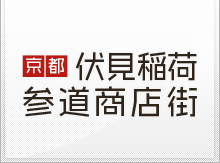Intorduction to Fushimi Inari
Home > Inari Tourist Guide > Intorduction to Fushimi Inari
-


Fushimi-Inari shrine is the head shrine of Inari shrines in Japan.
The story explaining the origin of Fushimi-Inari appeared in Yamashiro-koku Fudoki.
According to this story there once lived a man called Hatano Irogu. He was comfortably situated and he had great power at that time.
One day, he shot an arrow at a target made of rice-cake.
Then, suddenly the rice-cake became a swan and flew away to the edge of a mountain.
After that, rice grew there in exchange of for Hatano Irogu is fame and fortune.
However, gradually, his power declined, so he built a shrine and enshrined rice as the god there. The word ‘Inari’ means to grow rice.
Therefore, since old days, Fushimi-Inari has been well-known as a guardian deity of agriculture.
It is also famous for prosperity in business, family security and even as a god of progress in the world of entertainment! From ancient times, there was mountain worship in Japan; considering a mountain as a god and respecting it as such. Hence, still now people think of Inari Mountain as a holy place. -


If using Omote-sandou (the main approach to a shrine) your eyes will be met by a splendid, large vermilion gate (Rou-mon) above stone stairs.
This Rou-mon was built in 1588 by Toyotomi Hideyoshi(feudal warlord in the age of provincial wars) for the sake of his mother.
At that time, she was very sick, so her son had the Rou-mon built as an offering so that his mother might be healed of her sickness. -


After passing through the Rou-mon, you can’t miss the main shrine, Honden.
It was once burned down during the O-nin war.
The present Honden was reconstructed in 1499 and has been designated as an important cultural property of Japan.
This Honden is constructed in the so-called Uchikoshi style of building.
When viewing the dramatic curvature of the expansive roof, one cannot fail to be impressed. -


The ocha-ya is located on the right of the Honden.
It too has obtained the status of important cultural property.
The Ocha-ya and garden are sometimes said to almost a mini-version of the famous Shugakuin Imperial Villa at in North Kyoto. Usually it is not open to the public.

1.The Vermillion of Inari
The color vermillion is applied to Honden, Torii, etc. and signifies authority to oppose magic and evil intentions.
It is a sacred color of Inari.

2.Foxes
Foxes are considered the servants of god.
In Inari in particular we find the famous white fox, which is a sacred animal, not visible to the naked eye.

3.Torii (Gateway at the entrance to a Shinto shrine)
Any time you go to a Shinto shrine you will encounter the large, brightly painted gates known as Torii.
They are considered to be the entrance to a holy place.
There are more than 10,000 of them here in Fushimi-Inari shrine precincts now dedicated by believers.

4.Senbon Torii (Thousand Toriis)
On the way to Okusha-Houhaisho from Honden, there is a tunnel of two lines.
These Torii have been made famous by TV and books and are called ‘Senbon Torii’, a thousand Torii.
Actually the real number does not reach 1000, but the difference is imperceptible.
Formerly, there were, in fact, 1000 torii.
This approach to the shrine is well-suited to the name ‘tunnel of vermilion’and is truly a sight worth seeing.

5.Omokaru ishi (mysterious stone)
When you visit Okusho-houhaisho, please try Omokaru ishi!
After passing through Senbon Torii you then arrive at Okusho-houhaisho.
There is a stone monument behind the shrine inscribed with a poem by the emperor Godaigo.
This mysterious stone is a fortune-telling stone!
If you want your fortune to be told, first you need to estimate the weight of the stone.
Then, pray for a wish, and lift it.
If you can lift it more easily than expected, ‘your wish will come true easily’; however, if you find it heavier than expected, ‘your wish will have difficulty coming true.’

6.Kumataka shrine
Behind Kumataka shrine, there is ‘Kumataka pond’, popularly know as ‘echo pond’.
It is said that when you clap your hands towards echo pond, the direction in which your ‘echo’ is returned is your lucky direction.
After you have found out the right direction for you, please make a wish.

7.Yotsu-Tsuji
You can see a view of the whole of Kyoto city here.
When the sky is clear in fine weather, you are able to see the high-rise buildings of Osaka city all the way from Kyoto city.

8.Oyama-Meguri (walking and praying in mountain of Inari)
After finishing paying homage at Honden, most people go the round of mountain of Inari.
It is called ‘Oyama-Meguri’.
There are many places to visit in the mountain, such as ‘God of eye disease recovery’, ‘God of a throat’, and ‘God of health’ various types of beneficial gods are there.
Take time and enjoy Oyama-Meguri.

























